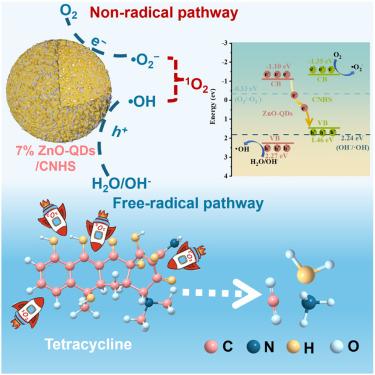ZnO量子点/空心球g- c3n4s型异质结光催化剂降解四环素的非自由基降解机理
IF 4.1
2区 综合性期刊
Q1 MULTIDISCIPLINARY SCIENCES
引用次数: 0
摘要
光催化技术是目前去除环境中四环素(TC)最有效的方法之一;然而,潜在的光催化机制尚不清楚。本研究合成了氧化锌量子点(ZnO-QDs)/空心球g-C3N4 (CNHS) S-scheme异质结光催化剂,用于光催化降解四环素。实验结果表明,7% ZnO-QDs/CNHS光催化剂具有优异的TC降解效率,在15 min内去除率可达80.2%。通过自由基转化途径分析,确定单线态氧(1O2)是四环素降解的主要活性物质。进一步计算表明,空穴(h+)和超氧自由基(O2−)结合产生1O2,占总贡献的83.28%。这些发现为o2作为污染物降解的主要活性物质提供了理论支持。本文章由计算机程序翻译,如有差异,请以英文原文为准。

Non-radical degradation mechanism on ZnO quantum dots/hollow-sphere g-C3N4 S-scheme heterojunction photocatalysts for tetracycline degradation
Photocatalytic technology is currently one of the most effective methods for removing tetracycline (TC) from the environment; however, the underlying photocatalytic mechanism remains unclear. In this study, zinc oxide quantum dots (ZnO-QDs)/hollow-sphere g-C3N4 (CNHS) S-scheme heterojunction photocatalysts were synthesized for the photocatalytic degradation of tetracycline. Experimental results showed that the 7% ZnO-QDs/CNHS photocatalyst exhibited excellent TC degradation efficiency, with a removal rate of 80.2% within 15 min. Through free radical conversion pathway analysis, singlet oxygen (1O2) was identified as the primary active species responsible for tetracycline degradation. Further calculations indicated that the combination of holes (h+) and superoxide radicals (O2−) produces 1O2, accounting for 83.28% of the total contribution. These findings provide theoretical support for 1O2 as the primary active species in pollutant degradation.
求助全文
通过发布文献求助,成功后即可免费获取论文全文。
去求助
来源期刊

iScience
Multidisciplinary-Multidisciplinary
CiteScore
7.20
自引率
1.70%
发文量
1972
审稿时长
6 weeks
期刊介绍:
Science has many big remaining questions. To address them, we will need to work collaboratively and across disciplines. The goal of iScience is to help fuel that type of interdisciplinary thinking. iScience is a new open-access journal from Cell Press that provides a platform for original research in the life, physical, and earth sciences. The primary criterion for publication in iScience is a significant contribution to a relevant field combined with robust results and underlying methodology. The advances appearing in iScience include both fundamental and applied investigations across this interdisciplinary range of topic areas. To support transparency in scientific investigation, we are happy to consider replication studies and papers that describe negative results.
We know you want your work to be published quickly and to be widely visible within your community and beyond. With the strong international reputation of Cell Press behind it, publication in iScience will help your work garner the attention and recognition it merits. Like all Cell Press journals, iScience prioritizes rapid publication. Our editorial team pays special attention to high-quality author service and to efficient, clear-cut decisions based on the information available within the manuscript. iScience taps into the expertise across Cell Press journals and selected partners to inform our editorial decisions and help publish your science in a timely and seamless way.
 求助内容:
求助内容: 应助结果提醒方式:
应助结果提醒方式:


